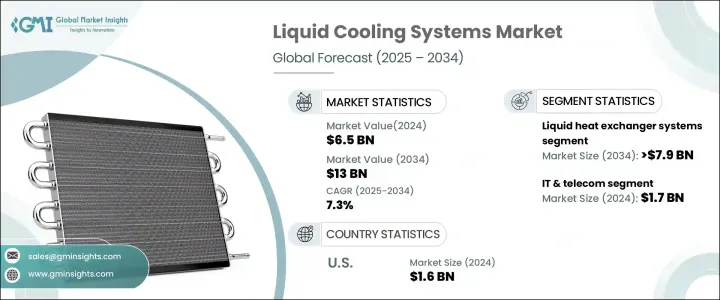
세계 액체 냉각 시스템 시장은 2024년 65억 달러로 평가되었고, 2025-2034년 연평균 7.3%의 성장률을 보일 것으로 예측됩니다.
고성능 컴퓨팅, 인공지능, 머신러닝에 대한 수요가 급증하면서 기존 공랭식 냉각에서 보다 효율적인 수냉식 냉각 솔루션으로의 전환이 가속화되고 있습니다. 서버의 전력 밀도가 급격히 증가함에 따라 공랭식 냉각 방식의 한계가 드러났고, 데이터센터는 액체 냉각을 탁월한 대안으로 채택하게 되었습니다. 열 관리 능력의 향상으로 액체 냉각은 고밀도 서버 환경에 대응하기 위해 필수적인 요소로 자리 잡았습니다. 업계 조사에 따르면, 액체 냉각은 방열 효율이 높고, 성능 향상과 에너지 절약을 실현합니다. 기업들이 최신 IT 인프라를 위한 에너지 효율적인 솔루션을 우선시함에 따라 시장은 꾸준히 성장하고 있습니다.

시장은 제품 유형에 따라 액체 열교환기 시스템과 압축기 기반 시스템으로 구분됩니다. 액체 열교환기 시스템은 2024년 40억 달러의 매출을 기록할 것으로 예상되며, 2034년에는 79억 달러를 넘어설 것으로 예측됩니다. 이러한 시스템은 액체 매체를 통해 열을 전달하여 기계적 압축에 대한 의존도를 낮추고 에너지 효율을 높입니다. 더 조용하고 고성능의 냉각 솔루션에 대한 선호도가 높아지면서 여러 산업 분야에서 액체 열교환기 시스템에 대한 수요가 크게 증가하고 있습니다.
| 시장 범위 | |
|---|---|
| 시작 연도 | 2024년 |
| 예측 연도 | 2025-2034년 |
| 시작 금액 | 65억 달러 |
| 예상 금액 | 130억 달러 |
| CAGR | 7.3% |
시장 세분화에서는 최종 사용자별로 BFSI, 헬스케어, 분석 기기, 산업, IT 및 통신, 자동차, 정부 및 방위, 기타 등 다양한 산업이 포함되며, 2024년에는 IT 및 통신이 17억 달러의 매출을 올리며 시장 점유율의 약 56%를 차지할 것으로 예상됩니다. 시장 점유율의 약 56%를 차지할 것으로 예상됩니다. 첨단 열 관리 솔루션에 대한 수요가 증가함에 따라 IT 및 통신 산업에서의 채택이 증가하고 있습니다. 클라우드 컴퓨팅, AI, 엣지 컴퓨팅으로 인해 데이터 처리 워크로드가 증가함에 따라 기존의 냉각 기술은 비효율적인 것으로 판명되었습니다. 액체 냉각은 고성능 컴퓨팅 환경에서 열을 효율적으로 관리하고, 에너지 소비를 줄이며, 전체 시스템 성능을 향상시킬 수 있는 능력으로 인해 점점 더 선호되고 있습니다. 업계 보고에 따르면, 액체 냉각 시스템은 공랭식 대비 최대 1,000배의 열 전달 효율을 달성할 수 있어 대규모 IT 인프라에 적합한 선택이 될 수 있습니다.
미국의 액체 냉각 시스템 시장은 2024년 약 16억 달러 규모에 달할 것으로 예상되며, 2025-2034년 연평균 8%의 성장률을 보일 것으로 예측됩니다. 고성능 컴퓨팅, 하이퍼스케일 데이터센터, 첨단 기술 인프라에 대한 미국의 높은 입지 등이 시장을 주도하는 요인으로 작용하고 있습니다. 기업들은 운영 효율성과 지속가능성을 높이기 위해 액체 냉각 솔루션에 빠르게 투자하고 있으며, AI, 머신러닝, 엣지 컴퓨팅으로 인해 데이터 처리 요구사항이 계속 증가함에 따라 기존의 냉각 방식은 더 이상 적합하지 않게 되었습니다. 혁신적인 냉각 기술에 대한 수요가 증가하면서 미국 액체 냉각 시스템 시장의 성장을 뒷받침하고 있습니다. 주요 기술 기업의 존재는 이 지역에서의 업계 입지를 더욱 공고히 하고 있습니다.
The Global Liquid Cooling Systems Market was valued at USD 6.5 billion in 2024 and is projected to expand at a CAGR of 7.3% from 2025 to 2034. The surge in demand for high-performance computing, artificial intelligence, and machine learning is accelerating the shift from traditional air cooling to more efficient liquid cooling solutions. The rapid increase in server power densities has exposed the limitations of air-based cooling methods, leading data centers to adopt liquid cooling as a superior alternative. Enhanced thermal management capabilities make liquid cooling indispensable for handling high-density server environments. According to industry research, liquid cooling delivers greater heat dissipation efficiency, ensuring improved performance and energy savings. The market is witnessing steady expansion as businesses prioritize energy-efficient solutions for modern IT infrastructure.

The market is segmented by product type into liquid heat exchanger systems and compressor-based systems. Liquid heat exchanger systems accounted for USD 4 billion in revenue in 2024 and are expected to exceed USD 7.9 billion by 2034. These systems provide superior energy efficiency by transferring heat through a liquid medium, reducing the reliance on mechanical compression. The increasing preference for quieter, high-performance cooling solutions is driving significant demand for liquid heat exchanger systems across multiple industries.
| Market Scope | |
|---|---|
| Start Year | 2024 |
| Forecast Year | 2025-2034 |
| Start Value | $6.5 Billion |
| Forecast Value | $13 Billion |
| CAGR | 7.3% |
By end-user segmentation, the market encompasses various industries, including BFSI, healthcare, analytical equipment, industrial, IT & telecom, automotive, government & defense, and others. IT & telecom emerged as the dominant segment in 2024, generating USD 1.7 billion in revenue and capturing approximately 56% of the market share. The growing need for advanced thermal management solutions is propelling adoption in IT and telecom industries. With data processing workloads intensifying due to cloud computing, AI, and edge computing, traditional cooling techniques are proving inefficient. Liquid cooling is increasingly favored for its ability to manage heat effectively in high-power computing environments, lower energy consumption, and enhance overall system performance. Industry reports suggest that liquid cooling systems can achieve heat transfer efficiency up to 1,000 times greater than air-based methods, making them a preferred choice for large-scale IT infrastructure.
The US market for liquid cooling systems stood at nearly USD 1.6 billion in 2024 and is set to grow at a CAGR of 8% between 2025 and 2034. The country's strong presence in high-performance computing, hyperscale data centers, and advanced technological infrastructure contributes to its market leadership. Companies are rapidly investing in liquid cooling solutions to enhance operational efficiency and sustainability. As AI, machine learning, and edge computing continue to push data processing requirements, traditional cooling approaches are becoming obsolete. The demand for innovative cooling technologies is growing, supporting the expansion of the liquid cooling systems market in the US. The presence of leading technology firms further strengthens the region's position in the industry.